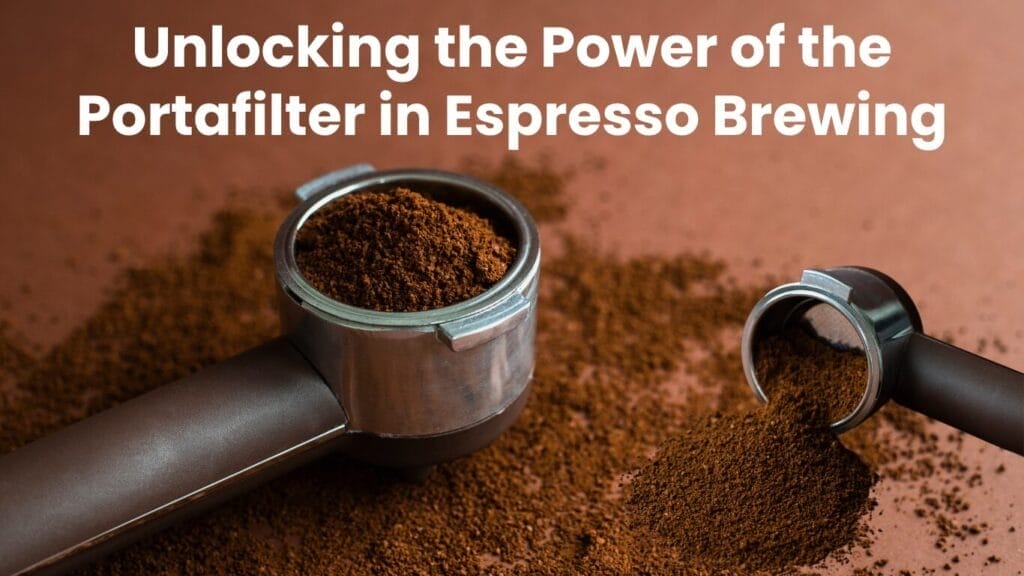If you’re tempted to scoop in your regular coffee grounds and hit “brew,” you’re not alone—but can you use coffee grounds in an espresso machine without ruining your shot or your machine? The answer depends on the grind size, freshness, and machine type.
fIn this guide, we’ll break down what works, what doesn’t, and how to get the bold espresso flavor you’re after without clogging your machine or compromising taste. For more brewing tips and expert advice, explore your coffee knowledge hub.
Table of Contents
Can You Use Coffee Grounds in an Espresso Machine Without Ruining It?

If you’re wondering whether you can use coffee grounds in an espresso machine without damaging it or ruining the flavor, you’re not alone. It’s a common question among home brewers, and the answer isn’t just a simple yes or no.
While you can use coffee grounds in an espresso machine, using the wrong type of grounds can lead to poor taste, clogged components, and even long-term machine issues.
Espresso machines are engineered for precision, particularly in terms of grind size, pressure, and water flow. Using grounds that are too coarse or too stale won’t just affect the flavor; it can compromise your machine’s performance.
Why the Grind Size Matters So Much
In order to drive hot water through compressed coffee grinds in around 25 to 30 seconds, espresso brewing utilizes 9 to 15 bars of pressure. For this to work correctly, the grind must be very fine and consistent, much finer than what you’d use for drip coffee or a French press.
- Too coarse? Water passes through too fast, producing a weak, under-extracted shot.
- Too fine or clumpy? The water may struggle to pass through, resulting in over-extraction, channeling, bitter flavors, or even clogs in the machine.
This is why not all coffee grounds are suitable for espresso machines, especially store-bought, pre-ground coffee, which is often inconsistent in texture and too coarse for proper espresso extraction.
Can You Use Pre-Ground Coffee in an Espresso Machine?

Technically, yes—but with serious limitations. Most pre-ground coffee is designed for brewing methods that don’t require high pressure, such as drip coffee, Moka pots, or pour-over. These grinds are typically too coarse and produce underwhelming, weak espresso with little to no crema.
What to Look for in Pre-Ground Coffee:
- Labels that say “espresso grind” or “fine ground”
- Airtight packaging to preserve freshness
- Roasts meant for espresso (medium to dark)
Still, even the best pre-ground espresso blends can’t match the quality of a freshly ground shot. Grinding your beans right before brewing is the best way to ensure peak flavor and ideal extraction.
Risks of Using Incorrect Coffee Grounds
Using coffee grounds that aren’t meant for espresso can do more than ruin your morning shot—it can damage your espresso machine over time. Proper cleaning and maintenance of your espresso machine can prevent clogging and wear. Here’s what to watch out for:
- Clogged portafilter, group head, or basket
- Uneven water flow or pressure fluctuations
- Over-extracted or under-extracted espresso
- Flat taste with little crema
- especially when dealing with inconsistent grind types. If you’re looking to upgrade your tools for better results, view espresso accessories designed for better durability and performance.
- Premature wear on the pump or seals
Inconsistent grounds also lead to “channeling,” where water carves a path through the puck, skipping much of the coffee and producing a weak, uneven extraction.
The Best Way: Grind Fresh with a Burr Grinder
If you’re serious about using coffee grounds in an espresso machine without ruining it, investing in a quality burr grinder is essential.
Why Burr Grinders Are Superior:
- Create consistent, fine grounds
- Offer precise grind size control
- Prevent overheating the beans (which can happen in blade grinders)
- Maximize flavor extraction and crema quality
Blade grinders, while cheaper, chop rather than grind beans, resulting in uneven particles that lead to over- and under-extraction in the same shot.
Choosing the Right Beans for Espresso
Grind size isn’t everything—the type of beans you use also plays a big role. Not all beans are ideal for espresso… and not every machine extracts equally. Here’s help with choosing the best espresso machine for your needs.
Best Practices:
- For intense crema and a deep flavor, use beans that have been roasted to a medium-dark to dark color.
- Avoid overly oily beans (they can clog the grinder and machine)
- Choose beans labeled “espresso roast” since they are most suited for pressure brewing.
Freshness also matters: for best results, use beans within 2–4 weeks of roasting.
How to Know If You’re Using the Right Grounds
If your espresso tastes flat, too bitter, or too sour—or if you’re not getting much crema—your grind may be off. Here’s how to test:
- Time your shot: A proper espresso should take 25–30 seconds to pull.
- Check the crema: Good espresso has a thick, golden crema on top.
- Taste it: Balanced flavor means you’re close to the sweet spot in grind and tamp. Key if you want to pull a perfect shot every time.
Can You Use Regular Coffee Grounds in an Espresso Machine, or Do You Need a Special Grind?
Using regular coffee grounds in an espresso machine might seem convenient, but it comes with real downsides. Espresso machines are built for precision brewing under pressure.
They rely on very fine coffee grounds and tightly packed pucks to create the resistance needed to extract bold, concentrated espresso in under 30 seconds.
If you use the wrong grind—like what’s intended for drip or pour-over methods—you’ll likely end up with weak coffee, a frustrated palate, and a machine that struggles to perform.
Why Regular Coffee Grounds Don’t Work for Espresso
Most store-bought, pre-ground coffee is intended for drip machines, French presses, or cold brew. These grinds are too coarse to work in an espresso machine, which needs backpressure for proper extraction.
Common Issues with Regular Grounds:
- Fast water flow results in weak, under-extracted espresso
- No crema, which indicates poor pressure or extraction
- Collapsed or uneven pucks affect flavor and consistency
- Channeling, where water flows through cracks instead of saturating the ground
Simply put, espresso machines require resistance, and regular grounds provide almost none.
What Is a “Special” Espresso Grind?
An espresso grind is ultra-fine, almost like powder. It’s crafted to allow hot water to push through slowly under high pressure, creating a full-bodied shot with rich crema and complex flavor.
Why the Special Grind Matters:
- Creates backpressure needed for 9–15 bars of pressure important in understanding 1-bar vs 15-bar espresso dynamics.
- Improves flavor extraction, delivering an intense coffee taste
- Enhances crema production, a sign of quality espresso
Espresso Grind vs. Regular Grind: Key Differences
| Feature | Regular Coffee Grind | Espresso Grind |
| Texture | Medium to coarse | Fine to very fine (powdery) |
| Intended Brewing Method | Drip, pour-over, French press | Espresso machine only |
| Water Contact Time | 2–4 minutes | 25–30 seconds |
| Pressure Required | Low or gravity-based | High-pressure (9–15 bars) |
| Flavor Result | Balanced or mild | Strong, concentrated, complex |
What Happens If You Use the Wrong Grind?
Trying to save time by using regular grounds in an espresso machine may backfire.
Problems You May Encounter:
- Watery espresso that tastes sour or acidic. If your espresso tastes sour or bitter, check your grind and tamping.
- Inconsistent extraction with channeling or uneven pressure
- No crema, indicating poor pressure or grind mismatch
- The machine may experience stress, which could reduce its longevity.
- Messy cleanups and clogged portafilters
Even worse, long-term use of incorrect grounds can cause wear and tear on internal components like the pump, solenoid valve, or gasket rings.
How to Get the Right Grind for Espresso
To ensure the best flavor and protect your machine, it’s crucial to use the correct grind. The best solution? Grind your beans with a burr grinder.
Tips for Getting the Perfect Espresso Grind:
- Use a burr grinder, not a blade grinder (for uniformity)
- Adjust grind settings based on shot time (ideal pull is 25–30 seconds)
- Use espresso-specific beans for proper flavor balance
- Grind right before brewing to retain oils and scent.
If you can’t grind your own, choose espresso-labeled pre-ground coffee from a trusted brand—but always check the roast date and seal.
Signs You’re Using the Right Espresso Grind
Not sure if your grind is on point? Here are signs you’ve nailed it:
- The espresso pulls in 25–30 seconds
- You see thick, golden crema on top of the shot
- The flavor is balanced, strong, and slightly sweet, indicating proper grind, tamp, pressure, and ideal espresso brew temperature.
- The puck is evenly compressed, not soupy or cracked
- There’s no sputtering or spitting during the shot
These indicators mean your grind, tamping, and machine pressure are all in sync.
FAQs|| Can you use coffee grounds in an espresso machine
What happens if you use regular coffee grounds in an espresso machine?
You’ll get weak, watery espresso with no crema, and risk clogging the machine due to poor pressure and improper extraction.
Can pre-ground coffee be used in an espresso machine?
Yes, but only if it’s labeled “espresso grind.” Regular pre-ground coffee is usually too coarse and won’t produce proper flavor or crema.
How fine should coffee grounds be for an espresso machine?
Espresso grounds should be very fine—similar to table salt or powdered sugar—to allow proper pressure and extraction in 25–30 seconds.
Can you use store-bought ground coffee in an espresso machine?
Only if it’s specifically ground for espresso. Most store-bought grounds are too coarse and not suitable for pressure-based brewing.
Will using the wrong grind damage my espresso machine?
Yes, it can cause clogs, stress the pump, and lead to frequent maintenance or long-term wear on internal components.
Conclusion
So, can you use regular coffee grounds in an espresso machine? Technically, yes—but it’s far from ideal. Using the wrong grind leads to weak flavor, poor extraction, and even machine damage over time. Espresso demands precision: a fine, consistent grind that builds pressure and delivers bold, balanced flavor.
Whether you grind fresh at home or buy budget espresso-labeled pre-ground coffee, always choose the right grind for the job. It’s the key to protecting your machine, pulling rich crema, and enjoying café-quality shots every time.







